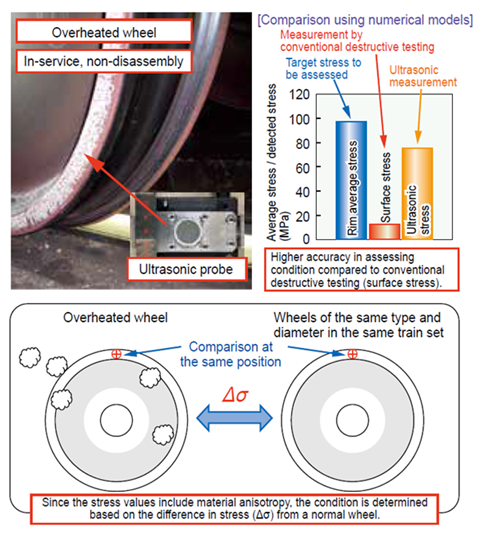4. Method for Identifying Wheel Usage Limit Temperature and Evaluating Safety While in Service
Wheels generally have sufficient thermal capacity to handle normal tread brake heat loads. However, in cases of abnormal overheating caused by failures such as tread brake air valve malfunctions, tensile residual stresses can develop in the wheel, which may lead to cracking or breakage in the worst cases. In such situations, the condition of the wheel has traditionally been qualitatively assessed based on deformation or paint peeling. However, because the limit temperature and deformation behavior vary among different wheels, there has been a demand for more quantitative evaluation criteria.
Therefore, numerical analyses were conducted on various wheels used for tread brakes to clarify the relationship between temperature rise and the limit temperature at which the wheel undergoes plastic deformation. Additionally, a method was developed to easily estimate the residual stress generated beyond the limit temperature based on the wheel’s deformation amount (Figure 1). Furthermore, as a method applicable even to wheels with minimal deformation, we developed a residual stress estimation technique using an ultrasonic (acoustoelastic) device. This method determines the stress state based on differences in measurements between wheels of the same type and diameter within the same train set, according to the measurement principle (Figure 2).
These methods enable high-precision assessment of wheel stress conditions non-destructively and without disassembly while the vehicle is in service when abnormal wheel overheating is detected. This allows for rapid decision-making regarding continued operation, wheel replacement, or vehicle deadheading, ensuring safety is maintained.
Other Contents
- 1. Performance Evaluation Method for Earthquake Early Warning Systems
- 2. Method for Setting Regulation Values for Operation Control Under Rainfall Using Radar Rain Gauges
- 3. Method for Estimating Track Buckling Risk Based on On-board Measurements
- 4. Method for Identifying Wheel Usage Limit Temperature and Evaluating Safety While in Service
- 5. Investigation of Front Rod Fracture Causes and Maintenance Methods to Prevent Fracture
- 6. Detection System for DC High-resistance Ground Faults by Utilizing the Current Data of Both Substations and Vehicles
- 7. Forward Obstacle Detection System for Trains in Preparation for Future Driverless Operation
- 8. Validation of the Long-term Effectiveness of Automatic Deerdeterrent Sound Devices
- 1. Performance Evaluation Method for Earthquake Early Warning Systems
- 2. Method for Setting Regulation Values for Operation Control Under Rainfall Using Radar Rain Gauges
- 3. Method for Estimating Track Buckling Risk Based on On-board Measurements
- 4. Method for Identifying Wheel Usage Limit Temperature and Evaluating Safety While in Service
- 5. Investigation of Front Rod Fracture Causes and Maintenance Methods to Prevent Fracture
- 6. Detection System for DC High-resistance Ground Faults by Utilizing the Current Data of Both Substations and Vehicles
- 7. Forward Obstacle Detection System for Trains in Preparation for Future Driverless Operation
- 8. Validation of the Long-term Effectiveness of Automatic Deerdeterrent Sound Devices


